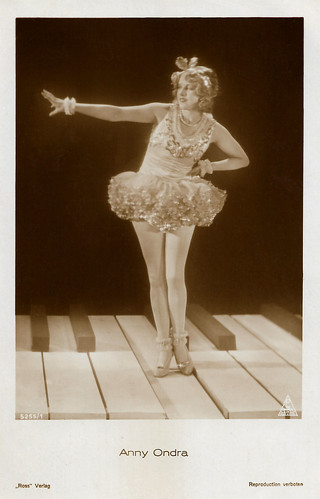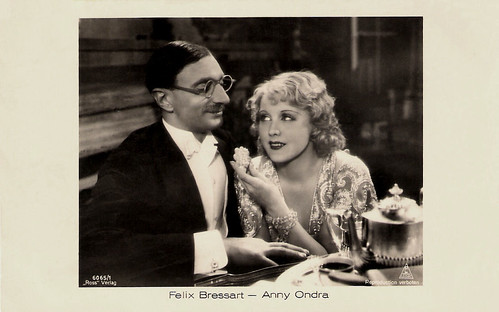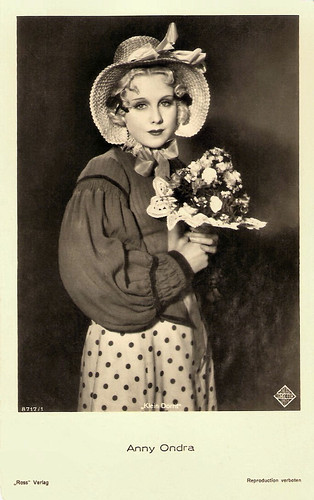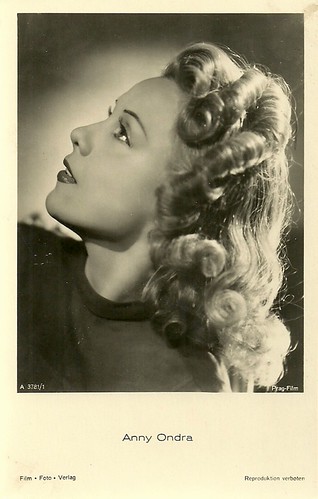
German postcard by Ross Verlag, no. 4250/1, 1929-1930.

German postcard by Ross Verlag, no. 4451/1, 1929-1930. Photo: Atelier Schlosser & Wenisch, Prague.

German postcard by Ross Verlag, no. 4774/2, 1929-1930. Photo: Hom Film. Publicity still for Sündig und süss/Sinful and Sweet (Karel Lamac, 1929).

German postcard by Ross Verlag, no. 4925/2, 1929-1930. Photo: Balzar, Praha (Prague).

German postcard by Ross Verlag, no. 4925/3, 1929-1930. Photo: Balzar, Praha.

German postcard by Ross Verlag, no. 5255/1, 1930-1931. Photo: Ondra-Lamac-Film. Anny Ondra in Die vom Rummelplatz/Those of the Sideshow (Karel Lamac, 1930).
Sinful and Sweet
Anny Ondra was born Anna Sophie Ondráková in Tarnów, Austria-Hungary, now Poland, in 1903. As the daughter of an Austro-Hungarian army Colonel, she spent her childhood in Prague. After convent school, she studied acting with Professor Bor.
Already as a child and teenager, she played big parts on the stages of Czechoslovakia, where she was discovered at the age of 16 by actor-director Karel (or Carl) Lamac. They starred together in the film Palimpsest (1919, Joe Jencik). Lamac would also become her first husband.
From 1919 on Anny Ondra often worked together with Lamac as her director and/or her co-star. With their film Gilly po prve v Praze/Gilly zum ersten Mal in Prag/Gilly for the First Time in Prague (Karel Lamac, 1920) she became a big comedy star in the silent Czechoslovakian and Austrian cinema.
Other popular films were Otrávené svetlo/Poisoned (Jan S. Kolár, Karel Lamac, 1921), Führe uns nicht in Versuchung/Don't Lead Us in Temptation (Sidney M. Goldin, 1922), Chytte ho!/Grab it! (Karel Lamac, 1925) and <1>Hrabenka z podskalí/Countess of Podskalí (Karel Lamac, 1926).
From 1928 on she also became a popular star in British and German cinema with films like Evas Töchter/Eve's Daughter (Karel Lamac, 1928) and Sündig und süss/Sinful and Sweet (Karel Lamac, 1929).

Czech postcard, no. 53. Photo: Willy Ströminger, Praha. Karel Lamač and Anny Ondra.

Austrian postcard by Iris Verlag, no. 612. Photo: Sascha Film, the Austrian film company where Anny Ondra worked in the late 1920s.

Austrian postcard by Iris-Verlag, no. 5334. Photo: Lux-Film Verleih. Karel Lamač and Anny Ondra in Kvet ze Sumavy/A Flower of the Sumava Mountains (Karel Lamac, 1927).

Austrian postcard by Iris-Verlag, no. 5902. Photo: HOM A.g. / Norbert u. co.

French postcard by Cinémagazine-Edition, Paris, no. 537.

French postcard by Cinémagazine-Edition, Paris, no. 707. Photo: Sofar. Anny Ondra in Sündig und süß/Sinful and Sweet (Karel Lamac, 1929), released in France as Anny de Montparnasse.
Blackmail
In her British films, Anny Ondra proved an impressive dramatic actress, most notably in Alfred Hitchcock's The Manxman and Blackmail (both 1929). The Manxman, a melodrama set on the Isle of Man, was Hitchcock’s last silent film.
In his first talking film, the thriller Blackmail (1929), Anny Ondra became the first of his 'Blondes'. Blackmail was also the first British feature-length sound film.
Knowing that not all theatres supported talkies yet, Hitchcock also filmed a silent version of Blackmail. Ondra's thick accent was considered unacceptable for the sound version, so her dialogue was recorded by actress Joan Barry.
Ondra's strong Czech accent precluded a continuation of her international career after the conversion to sound. She settled in Germany. In 1930 she created there with the help of Karel Lamac the Ondra-Lamac Film Society, which lasted till 1936. She starred in Die vom Rummelplatz (Karel Lamac, 1930) but the film got lost up till this day.
She especially concentrated on operetta films and was very successful with Die Fledermaus/The Bat (Karel Lamac, 1931), Mamsell Nitouche (Karell Lamac, 1932) and Kiki (Karel Lamac, 1932). She played in German, Czech, and French versions of all her films, always as the leading lady. Because of her talent and her various characters she became one of the most beloved German film stars and an international superstar.

Dutch postcard by JosPe, no. 285. Photo: Remaco. Anny Ondra in Eine Nacht im Paradies/One Night in Paradise (Karel Lamac, 1932).

Dutch postcard by JosPe, no. 287. Photo: Remaco. Ralph Arthur Roberts and Anny Ondra in Eine Nacht im Paradies/One Night in Paradise (Carl Lamac, 1932).

Dutch postcard by City Film, no. 492. Photo: publicity still for Fräulein Hoffmanns Erzählungen/The Tales of Ms. Hoffmann (Karel Lamac, 1933) with Ida Wüst.

Dutch postcard by City Film, no. 606. Anny Ondra in Die vertauschte Braut/The Love Hotel (Karel Lamac, 1934). The alternative title was Anny und Anny.

Dutch postcard. Photo: City Film. Hermann Thimig and Anny Ondra in Kiki (Karel Lamac, 1932).

Dutch postcard by Remaco, no. 288.

Dutch postcard by Remaco, no. 331.

Dutch postcard by Filma, no. 588. Anny Ondra and Matthias Wieman in Klein Dorrit/Little Dorit (Karel Lamac, 1934), based on the novel by Charles Dickens. Kleine Dora was the Dutch film title.

Dutch postcard by Filma, no. 620. Photo: still from Polenblut (Karel Lamac, 1934). Collection: Geoffrey Donaldson Institute.
Heavyweight Champion
In 1933, Anny Ondra married the boxer Max Schmeling, the heavyweight champion of the world. They appeared together in the film Knockout - Ein junges Mädchen, ein junger Mann/Knockout (Karel Lamac, Hans H. Zerlett, 1935).
Anny Ondra suffered a miscarriage as a result of an automobile accident. The couple eventually had no children. The marriage lasted until her death in 1987.
After Karel Lamac had to leave Germany in 1937, Ondra appeared only rarely in films. In Czechoslovakia, they made together Duvod k rozvodu/Grounds for Divorce (Karel Lamac, 1937). After Himmel, wir erben ein Schloss/Heaven, We Inherit A Castle (Peter Paul Brauer, 1942) it took eight years till Anny Ondra played in a new film.
Her appearance in the musical Schön muss man sein/One Must Be Handsome (Ákos Ráthonyi, 1951) with Sonja Ziemann, Willy Fritsch and Hardy Krüger would be her last.
All together Anny Ondra made more than 88 films. For her work, she was awarded the Filmband in Gold (Golden ribbon) in Germany in 1970. Anny Ondra died in 1987 in Hollenstedt, near Hamburg. Max Schmeling died in 2005 and was buried next to her at the Saint Andreas Friedhof cemetery in Hollenstedt.

German postcard by Ross Verlag, no. 4817/1, 1929-1930. Photo: Atelier Böhm, Berlin.

German postcard by Ross Verlag, no. 5298/1, 1930-1931. Photo: Atelier Balzar, Prag (Prague).

German postcard by Ross Verlag, no. 5530/1, 1930-1931. Photo: Becker & Maass, Berlin.

German postcard by Ross Verlag, no. 6065/1, 1931-1932. Photo: Ondra Lamac Film. Publicity still for Eine Freundin so goldig wie Du/A cute girlfriend like you (Karel Lamac, 1930) with Felix Bressart.

German postcard by Ross Verlag, no. 6348/1, 1931-1932. Photo: Vandor-Film / Ondra Lamac-Film. Anny Ondra in Die Fledermaus/The Bat (Karel Lamac, 1931).

German postcard by Ross Verlag, no. 7626/2, 1932-1933. Photo: Ondra-Lamac-Film.

German postcard by Ross Verlag, no. 8048/1, 1933-1934. Photo: Atelier Mahrenholz, Berlin.

German postcard by Ross Verlag, no. 8717/1, 1933-1934. Photo: Ondra-Lamac-Film. Still from Klein Dorrit/Little Dorrit (Karel Lamac, 1934).

German postcard by Ross Verlag, no. A 1013/1, 1937-1938. Photo: Ströminger. Anny Ondra and Max Schmeling in Knockout - Ein junges Mädchen, ein junger Mann/Knock-out (Karel Lamac, Hans H. Zerlett, 1935).

German postcard by Film-Foto-Verlag, no. A 3781/1, 1941-1944. Photo: Prag-Film.
Scene from Flitterwochen (Karl Lamac, 1936) with Hans Söhnker. Source: Sexena 1999 (YouTube).
Sources: Tim Bergfelder (Encyclopedia of British Film), Rudi Polt (IMDb), Wikipedia, and IMDb.
Anny was married to Max Schmeling huh? How about that. Wonderful post Bob. I really don't know how you find all these interesting stories. Thank you.
ReplyDeleteThis comment has been removed by the author.
ReplyDeleteThanks. Her films are great, and I mean not only Blackmail. Something to rediscover.
ReplyDeleteShe has one of those classic faces. I loved reading about her life. Thank you for sharing her with us.
ReplyDelete